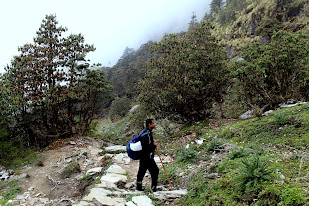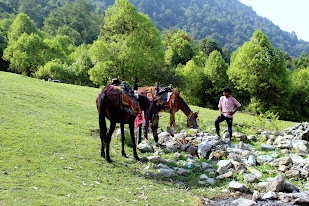Rudranath: The Majestic Kedar of Uttarakhand
In the night of Saturday, 17 May, two of us got into a night bus from ISBT Kashmiri Gate, Delhi for Haridwar where Aniket would send a car for us to travel to Sagar, the starting point of Rudranath trek. The sun spread its first rays over the Holy Ganga as we alighted from the bus in Haridwar. Everywhere it created a perfect picture of peace and tranquillity. I have travelled to this ancient city many a time since my childhood, sometimes with my grandparents, sometimes with my parents or friends. When my brother was just one-year-old kid, I carried him to the top of the Chandi Hill on the outskirt of Haridwar. I reminisced those old stories and told him as we walked down to the GMVN Hotel Alaknanda on the Delhi Bypass Road where the driver would pick us up.
As we were waiting at the open compound, we were introduced to our amazing companions – Dr Samarendra Narayan and Dr Dipti Agarwal the physician couple from Lucknow and their bright son Kishu, a medical student at the King George's Medical University. Fond of mountain travel, they came all the way from the City of Nawabs with an earnest wish to see the abode of Rudra or Shiva. The driver Praval, a stout man in his 30s from Gopeshwar, drove the new jeep fast towards Sagar. By 2’o clock we were at the home stay booked for us by the travel agency. Five of us put up at a moderate dormitory arranged neatly for the travellers. Early morning the next day, guided by the village lad Krish, we set off the journey from Sagar. Energy and enthusiasm made us stronger. Carrying a large wooden stick in right hand to support the body, we walked past the village to the registration counter where each traveller was asked to pay a government fee of Rs 200. A gradually inclined forested path led us to the Pung Bugiyal, the first high-altitude meadow on the way. There was a clean sun-drenched natural lawn that welcomed us with red chairs and tables kept by the locals to enjoy tea and Aloo Paratha. This rejuvenating break was something that we were looking for. But there was no time to wait long at Pung as we had to cover another 6 Km to reach the night shelter at Lewti Bugiyal. We did not know that this was to be the toughest trek for the day.After the Pung Bugiyal, we climbed uphill through a damp forest, almost like a hungry serpent. The stony path was becoming rougher and steeper, difficult to be travelled by those with no experience of mountain walk. As we got tired, we never stopped on a stone, but rest awhile with the support of the wooden stick. The cool breeze coming from the heaven helped us refresh in a few minutes. We were no longer covered with jacket, woollen cap and scarf, as the body was sweating. The winter garments were stored into the backpack which only became a little heavier. Two of us I walked one after another, sometimes side by side, talking about our long-gone days when life seemed simple like a fresh wildflower. Stories of the past made us ignore what we were crossing in the present.
The next resting place after the Pung Bugiyal came after about three hours of trek – a shaded part of the hill guarded by trees, where a few tents were installed. This was Mouli Kharak, not a proper village, but a small stay on the way. Those riding on horse stopped here for a short or long break. But decided not to take a rest at the Mouli Kharak, but proceed to Lwiti Bugiyal which was not far from where we were standing. We got to know after reaching Lwiti that the guide Krish had already arranged a tent for us.
The other travellers in our group came within a few hours. The sky was getting dark after 2’o clock; there were signs of thunderstorm followed by rain. In total there were 14 people to be accommodated in the same sturdy tent. Stretching our legs under the blanket, we chatted with others. We got to know two friends Sudakshina Basu and Santanu Ganguli, both senior academicians, who came from Kolkata. In the dim corner of the tent, our idle talks made our bonds stronger with the unknown. We could hear the cracks of thunderbolts accompanied by incessant rain. Some amount of fear and anxiety raised in my mind. Shall we be able to take the next day’s trek? Continuous rain could have made it impossible to go further. Our dates of travel were fixed as we were bound by the duties in the office. The exhausted body went into deep sleep as we finished our dinner – a wonderful mix of roti and sabji. As I woke early morning the next, a faint touch of the first sun kissed the remote valley. Finishing the first task was the most ridiculous one. The temporary toilet which was installed nearby had no trace after the storm. Going in the open was the only norm one could do. Hot tea, much required during treks, was served in steel glasses, and we got ready for the day’s walk to the destination Rudranath. Krish told us that he would wait for the tent men to make Parathas and carry them for us to the Panar Bugiyal. The hilly terrain got steeper straight from Lwiti. Holding our sticks tighter, we moved up and up leaving our first night’s stay far behind like a little spot. Though it was not very chilly, we covered ourselves with winter clothes, only to put them in the backpack as we trekked further. It took around two hours to reach Panar Bugiyal, the lush green valley guarded by the glorious peaks of Trishul, Nandadevi and Nandaghunti. The worldly feelings of possessions and worries become lighter at this place, as one imagines himself connected with the vastness of the supreme. The cover of the heaven was open before our eyes – the mind and body both were immersed in the mystery of enormous nature. Krish and our doctor friends appeared in a short while, and we were handed in the breakfast packet. Taking an hour-long break at Panar was not only meant for gaining energy but taking photographs of the heavenly landscape. After Panar, the vegetation drastically changed – it turned grassy interspersed with a few woodlands. We met the pilgrims coming back from Rudranath. “How far is the temple from here?” we asked. Interestingly all gave different answers as it depended on strength, speed and energy. The travellers greeted each other with the holy names of Lord Shiva. The chants “Om Namah Shivaya” or “Har Har Mahadev” made this difficult trek auspicious and effervescent.We were walking in the land of a supernatural entity that was drawing us closer to him. No amount of beat made us disheartened. The highest point on this route is Pitridhar (3650 meters) which came after a two-hour walk from Panar. At this ridge, pilgrims from the hills offer prayers and perform rituals for their ancestors. We met a group of hill people – men and women – who were returning in cheering voice from Rudranath. One of the ladies spoke to us, “The steepness will be over soon. You will soon walk downhill which will lead you to Rudranath. Don’t worry; that’s an easy route.” This was an assurance which helped us speed up. But after crossing a few more ridges, we realised that the trekking route was becoming narrower and risky. We had to crawl at some narrow points to get hold of the only stone on one side. The other side had nothing, but straight downfall. With the chants of the God of gods, we stepped into a meadow that was surrounded by blue rhododendrons. It seemed the flowers were calling the clear-blue sky to make friendship. The end of this route – the temple at a far distance – was finally visible. The thin line of the temple painted in red appeared as a message from the divinity. We spotted a few glaciers stuck to the surface of the mountain like a white mark. The tiring body coped up with the ups and downs, making movement slow and quiet in this beautiful landscape. Though we were a carrying a camera, we were so focused on the road, so careful to move that we often forgot to click what was seen on the panorama. Sometimes I hang the camera bag from my shoulder, sometimes it was handed over to my brother. Of course we saved time to take pictures, but those pictures are unable to explain what we experienced. Guarded by the mountains, and decorated by rhododendrons, the temple along with its backdrop created a wide unit of divinity that is indescribable, inexplainable.
Reaching the temple steps, we put off our shoes, washed our hands and entered the stony courtyard next to the cave where the Lord’s face was being worshipped by the priest and his teenage son Rudraksh. Mother sent a silver Bilva leaf for the Lord. With the sacred chanting of the priest, we paid our humble tribute to the deity. I sat on the floor outside the temple when my brother took a seat inside the temple. Both were overwhelmed by an inward vibration which was peaceful and assuring. Advised by the little priest Rudraksh, we also walked along the narrow mountain path below the Rudranath temple. This led us to the small sacred pond, called Saraswati Kund in the middle of a meadow; half covered with mist and sprinkled with yellow wildflowers. A small temple dedicated to Goddess Saraswati, erected near the pond, exuded the glory of this mythical place. I could imagine a scene of the Lord sitting above his Bull carrier and the Goddess Parvati standing near him for an early morning bath. I could feel an enchanting divinity at this corner of the earth. As we listened to the ancient chants recited by the priest during the evening Aarti, the last light of the sun fell on the mountain tops to make them more glorious. We were offered the prasadam of tea and Khichri made by the temple volunteers. The mind and stomach both were fulfilled with what was desired. Slowly we came back to the tent about 50 steps down the temple, kept our backpacks inside and lay down under the warm cover of our blankets. Our friends, the other travellers also joined us in light chats and sharing experiences of the long trek. We bonded over shared struggles and laughter, creating memories that felt deeper than the valleys we crossed. For all, the entire journey was such special that it can be preserved and cherished for a lifetime.









Very beautifully penned with intricate details...will be a guide for future travellers
ReplyDelete